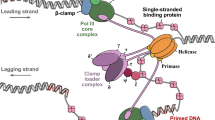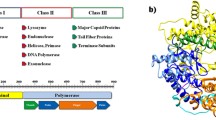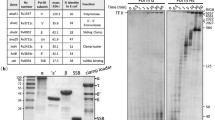Abstract
Tuberculosis, caused by Mycobacterium tuberculosis, is one of the most common causes of death in the world. Mycobacterium tuberculosis -sliding clamp is a protein essential for many important DNA transactions including replication and DNA repair proteins, thus, a potential drug target for tuberculosis. Further investigation is needed in understanding DNA polymerase sliding clamp structure, especially from a computational perspective. In this study, we employ a wide-range of comparative molecular dynamic analyses on two systems: Mycobacterium tuberculosis - sliding clamp enzyme in its apo and bound form. The results reported in this study shows apo conformation to be less stable, as compared to bound conformation with an average radius of gyration of 25.812 and 25.459 Å, respectively. This was further supported by root mean square fluctuation, where an apo enzyme showed a higher degree of flexibility. However, the presence of the ligand lowers radius of gyration and root mean square fluctuation and also leads to an existence of negative correlated motions. Principal component analysis further justifies the same findings, whereby the apo enzyme exhibits a higher fluctuation compared to the bound complex. In addition, a stable 310 helix located at the binding site appears to be unstable in the presence of the ligand. Hence, it is possible that the binding of the ligand may have caused a rearrangement of the structure, leading to a change in the unwinding of 310 helix. Findings reported in this study further enhance the understanding of Mycobacterium tuberculosis -DnaN and also give a lead to the development of potent tuberculosis drugs.








Similar content being viewed by others
References
Jnawali, H. N., & Ryoo, S. (2013). First—and second—line drugs and drug resistance. Tuberc Issues Diagnosis Management, pp. 163–180. Available from: http://dx.doi.org/10.5772/54960
Be, N. A., Kim, K. S., Bishai, W. R., & Jain, S. K. (2009). Pathogenesis of central nervous system tuberculosis. Current Molecular Medicine, 9(2), 94–99. Retrieved http://www.pubmedcentral.nih.gov/articlerender.fcgiartid=4486069&tool=pmcentrez&rendertype=abstract from 4 Sep 2015.
Gusmão, L., Galvão, J., & Alfarroba, E. (1998). Tuberculosis and the kidney. Acta Medica Portuguesa, 11(12), 1107–1111.
Cain, K. P., Anekthananon, T., & Burapat, C., et al. (2009). Causes of death in HIV-infected persons who have tuberculosis, Thailand. Emerging Infectious Diseases, 15(2), 258–264. doi:10.3201/eid1502.080942.
WHO (2015). Global Tuberculois Report 2015-Executive Summary. World Heal Organ:1–3. doi:10.1037/e530172011-002.
WHO | Tuberculosis. http://www.who.int/mediacentre/factsheets/fs104/en/. Accessed September 4, 2015
Wood, R., Lawn, S. D., Johnstone-Robertson, S., & Bekker, L. G. (2011). Tuberculosis control has failed in South Africa—time to reappraise strategy. South African Medical Journal, 101(2), 111–114.
Poce, G., Cocozza, M., Consalvi, S., & Biava, M. (2014). SAR analysis of new anti-TB drugs currently in pre-clinical and clinical development. European Journal of Medicinal Chemistry, 86(April), 335–351. doi:10.1021/jm500131s.
Shi Wanliang, Z. X. (2012). Pyrazinamide inhibits trans-translation in Mycobacterium tuberculosis: A potenatial mechnism for shortening the duration of chemotrerapy. Science (80- ), 333(6049), 1630–1632. doi:10.1126/science.1208813.Pyrazinamide.
Chakraborty, S., Gruber, T., Barry, C. E., Boshoff, H. I., & Rhee, K. Y. (2013). Para-aminosalicylic acid acts as an alternative substrate of folate metabolism in Mycobacterium tuberculosis. Science, 339(6115), 88–91. doi:10.1126/science.1228980.
Zumla, A., Nahid, P., & Cole, S. T. (2013). Advances in the development of new tuberculosis drugs and treatment regimens. Nature Reviews Drug Discovery, 12(5), 388–404. doi:10.1038/nrd4001.
Kling, A., Lukat, P., Almeida, D. V., Bauer, A., Fontaine, E., Sordello, S., Zaburannyi, N., Herrmann, J., Wenzel, S. C., Konig, C., Ammerman, N. C., Barrio, M. B., Borchers, K., Bordon-Pallier, F., Bronstrup, M., Courtemanche, G., Gerlitz, M., Geslin, M., Hammann, P. (2015). Antibiotics. Targeting dnan for tuberculosis therapy using novel griselimycins. Science (80-), 348,1106. doi:26045430.
WHO | What is multidrug-resistant tuberculosis and how do we control it? http://www.who.int/features/qa/79/en/. Accessed 4 Sep 2015.
Gui, W. -J., Lin, S. -Q., Chen, Y. -Y., Zhang, X. -E., Bi, L. -J., & Jiang, T. (2011). Crystal structure of DNA polymerase III β sliding clamp from Mycobacterium tuberculosis. Biochemical and Biophysical Research Communications, 405(2), 272–277. doi:10.1016/j.bbrc.2011.01.027.
Kukshal, V., Khanam, T., Chopra, D., Singh, N., Sanyal, S., & Ramachandran, R. M. (2012). tuberculosis sliding ??-clamp does not interact directly with the NAD + -dependent DNA ligase. PLoS One., 7(4). doi:10.1371/journal.pone.0035702.
Manuscript, A. (2012). NIH public access. Changes, 29(6), 997–1003. doi:10.1016/j.biotechadv.2011.08.021.Secreted.
Kongsuwan, K., Josh, P., Picault, M. J., Wijffels, G., & Dalrymple, B. (2006). The plasmid RK2 replication initiator protein (TrfA) binds to the sliding clamp ?? subunit of DNA polymerase III: Implication for the toxicity of a peptide derived from the amino-terminal portion of 33-kilodalton TrfA. Journal of Bacteriology, 188(15), 5501–5509. doi:10.1128/JB.00231-06.
Bunting, Ka, Roe, S. M., & Pearl, L. H. (2003). Structural basis for recruitment of translesion DNA polymerase Pol IV/DinB to the ??-clamp. EMBO Journal, 22(21), 5883–5892. doi:10.1093/emboj/cdg568.
Bjedov, I., Dasgupta, C. N., Slade, D., Le Blastier, S., Selva, M., & Matic, I. (2007). Involvement of Escherichia coli DNA polymerase IV in tolerance of cytotoxic alkylating DNA lesions in vivo. Genetics, 176(3), 1431–1440. doi:10.1534/genetics.107.072405.
Maul, R. W., Ponticelli, S. K. S., Duzen, J. M., & Sutton, M. D. (2007). Differential binding of Escherichia coli DNA polymerases to the beta-sliding clamp. Molecular Microbiology, 65, 811–827. doi:10.1111/j.1365-2958.2007.05828.x.
Meller J (2001). Molecular dynamics. Encyclopedia of Life Sciences, 1–8. doi:10.1021/jp909004y.
Sittel, F., Jain, A., & Stock, G. (2014). Principal component analysis of molecular dynamics: On the use of Cartesian vs. internal coordinates. The Journal of Chemical Physics, 141(1), 14–111. doi:10.1063/1.4885338.
Moonsamy, S., Bhakat, S., & Soliman, M. E. S. (2014). Dynamic features of apo and bound HIV-Nef protein reveal the anti-HIV dimerization inhibition mechanism. Journal of Receptors and Signal Transductors, 9893, 1–11. doi:10.3109/10799893.2014.984310.
Singh, A., Mhlongo, N., & Soliman, M.E.S. (2015). Anti-cancer glycosidase inhibitors from natural products : A computational and molecular modelling perspective. Anti-Cancer Agents in Medicinal Chemistry, 1 933–946.
Karplus, M., & McCammon J. A. (2002). Molecular dynamics simulations of biomolecules. Nature Structural Biology, 9(9), 646–652. doi:10.1038/nsb0902-646.
Pettersen, E. F., Goddard, T. D., & Huang, C. C., et al. (2004). UCSF Chimera—a visualization system for exploratory research and analysis. Journal of Computational Chemistry, 25(13), 1605–1612. doi:10.1002/jcc.20084.
Case, Da, Cheatham, T. E., & Darden, T., et al. (2005). The Amber biomolecular simulation programs. Journal of Computational Chemistry, 26(16), 1668–1688. doi:10.1002/jcc.20290.
Jorgensen, W. L., Chandrasekhar, J., Madura, J. D., Impey, R. W., & Klein, M. L. (1983). Comparison of simple potential functions for simulating liquid water. The Journal of Chemical Physics, 79(2), 926 doi:10.1063/1.445869.
Harvey, M. J., & De Fabritiis, G. (2009). An implementation of the smooth particle mesh Ewald method on GPU hardware. Journal of Chemical Theory and Computation, 5(9), 2371–2377. doi:10.1021/ct900275y.
Chetty, S., & Soliman, M. E. S. (2015). Possible allosteric binding site on Gyrase B, a key target for novel anti-TB drugs: Homology modelling and binding site identification using molecular dynamics simulation and binding free energy calculations. Medicinal Chemistry Research, 24(5), 2055–2074. doi:10.1007/s00044-014-1279-3.
Bhakat, S., Martin, A. J. M., & Soliman, M. E. S. (2014). An integrated molecular dynamics, principal component analysis and residue interaction network approach reveals the impact of M184V mutation on HIV reverse transcriptase resistance to lamivudine. Molecular Biosystems, 10(8), 2215–2228. doi:10.1039/c4mb00253a.
Karubiu, W., Bhakat, S., & Soliman, M.E.S. (2014). Compensatory role of double mutation N348I/M184V on nevirapine binding landscape: Insight from molecular dynamics simulation. The Protein Journal., 432-446. doi:10.1007/s10930-014-9576-8.
Case, D. A., Berryman,J. T., Betz, R. M., Cerutti, D. S., Cheatham, T. E. III., Darden, T. A., Duke, R. E., Giese,T. J., Gohlke, H., Goetz, A. W., Homeyer, N., Izadi, S., Janowski, P., Kaus, J., Kovalenko, A., Lee, T. S., LeGrand, S., Li, P., Luchko, T., Luo, R., Madej, B., Merz, K. M., Monard, G., Needham, P., Nguyen, H., Nguyen, H. T., Omelyan, I., Onufriev, A., Roe, D. R., Roitberg, A., Salomon-Ferrer, R., Simmerling, C. L., Smith, W., Swails, J., Walker, R. C., Wang, J., Wolf, R. M., Wu, X., York, D. M., & Kollman, P.A. (2015). AMBER 2015, University of California, San Francisco
Roe, D. R., & Cheatham, T. E. (2013). PTRAJ and CPPTRAJ: Software for processing and analysis of molecular dynamics trajectory data. Journal of Chemical Theory and Computation, 9(7), 3084–3095. doi:10.1021/ct400341p.
Yang, Y., Liu, H., & Yao, X. (2012). Understanding the molecular basis of MK2–p38α signaling complex assembly: Insights into protein–protein interaction by molecular dynamics and free energy studies. Molecular Biosystems, 8, 2106. doi:10.1039/c2mb25042j.
Fuglebakk, E., Echave, J., & Reuter, N. (2012). Measuring and comparing structural fluctuation patterns in large protein datasets. Bioinformatics, 28(19), 2431–2440. doi:10.1093/bioinformatics/bts445.
Huang, Y., & Paul, D. R. (2007). Effect of molecularweight and temperature on physical aging of thinglassy poly(2,6-dimethyl-1,4-phenylene oxide) Films. Journal of Polymer Science Part B Polymer Physics, 45(November), 1390–1398. doi:10.1002/polb.
Pan, L., & Patterson, J. C. (2013). Molecular dynamics study of Zn(Aβ) and Zn(Aβ)2. PLoS One., 8(9). doi:10.1371/journal.pone.0070681.
Wijffels, G., Dalrymple, B., Kongsuwan, K., & Dixon, N. E. (2005). Conservation of eubacterial replicases. IUBMB Life, 57(6), 413–419. doi:10.1080/15216540500138246.
López de Saro, F. J. (2009). Regulation of interactions with sliding clamps during DNA replication and repair. Current Genomics, 10(3), 206–215. doi:10.2174/138920209788185234.
Bloom, L. B. (2010). NIH Public Access. Loading Clamps for DNA Replication and Repair, 8(5), 570–578. doi:10.1016/j.dnarep.2008.12.014.
Oakley, A. J. (2016). Dynamics of open DNA sliding clamps. PLoS One, 11(5), e0154899. doi:10.1371/journal.pone.0154899.
Khrustalev, V. V., Barkovsky, E. V., & Khrustaleva, T. A. (2014). The influence of flanking secondary structures on amino acid content and typical lengths of 3 / 10 Helices. 1–13. Available from: doi:10.1155/2014/360230.
Yan, Y. -B., Wang, Q., He, H. -W., Hu, X. -Y., Zhang, R. -Q., & Zhou, H. -M. (2003). Two-dimensional infrared correlation spectroscopy study of sequential events in the heat-induced unfolding and aggregation process of myoglobin. Biophysical Journal, 85(3), 1959–1967. doi:10.1016/S0006-3495(03)74623-2.
Kumalo, H. M., & Soliman, M. E. (2016). Per-residue energy footprints-based pharmacophore modeling as an enhanced in silico approach in drug discovery: A case study on the identification of novel ??-secretase1 (BACE1) inhibitors as anti-alzheimer agents. Cellular and Molecular Bioengineering, 9(1), 175–189. doi:10.1007/s12195-015-0421-8.
Acknowledgments
The authors would like to acknowledge the School of Health Sciences, University of KwaZulu-Natal Westville campus for financial support and computational resources granted by San Diego and the Center for High Performance Computing (http://www.chpc.ac.za).
Author information
Authors and Affiliations
Corresponding author
Ethics declarations
Conflict of interest
The authors declare that they have no conflict of interests.
Rights and permissions
About this article
Cite this article
Machaba, K.E., Cele, F.N., Mhlongo, N.N. et al. Sliding Clamp of DNA Polymerase III as a Drug Target for TB Therapy: Comprehensive Conformational and Binding Analysis from Molecular Dynamic Simulations. Cell Biochem Biophys 74, 473–481 (2016). https://doi.org/10.1007/s12013-016-0764-3
Published:
Issue Date:
DOI: https://doi.org/10.1007/s12013-016-0764-3




